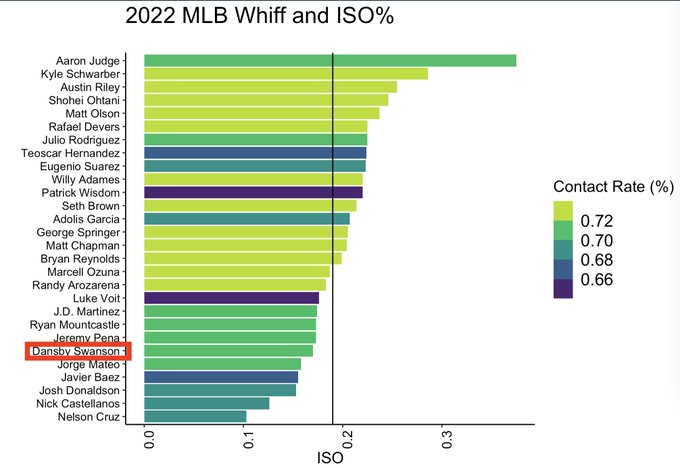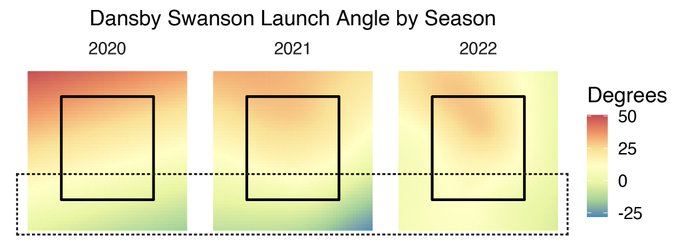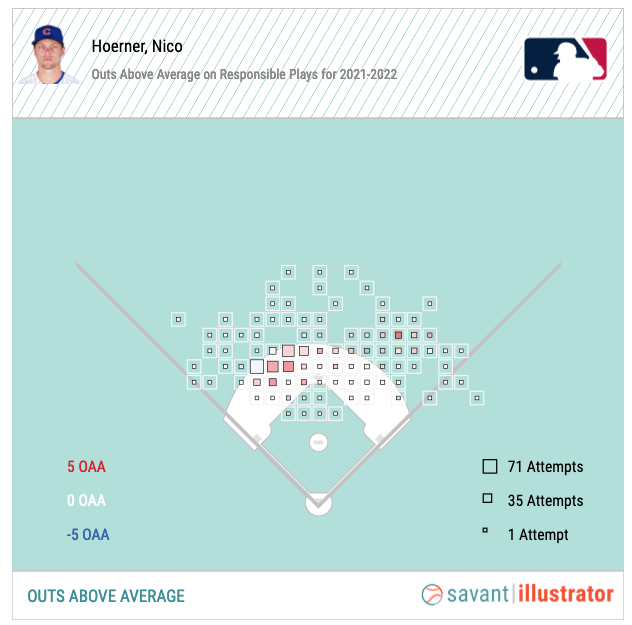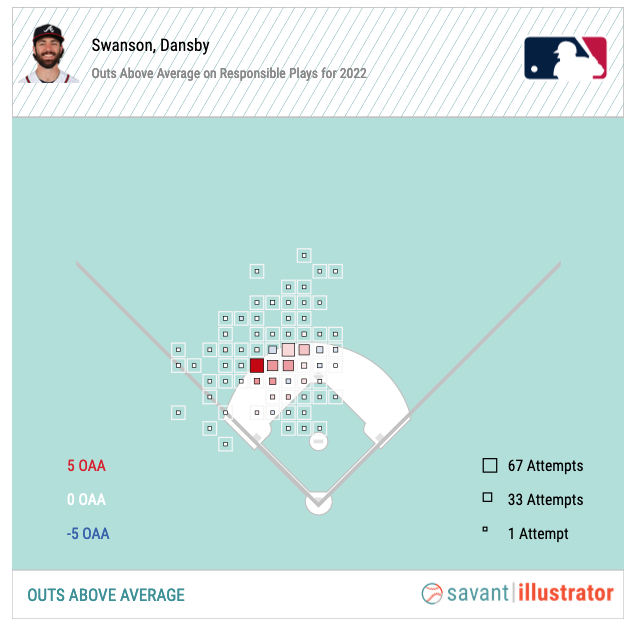© 2025 ALLCITY Network Inc.
All rights reserved.

The Cubs didn’t waste any more time to go and get their man. Dansby Swanson, one of the “Big Four” shortstops who hit the free agent market this offseason, is headed to Chicago after reportedly agreeing Saturday afternoon to a seven-year deal worth $177 million.
The deal may seem a bit steep for a shortstop who turns 29 in less than two months and only just made his first All-Star team. He’s graded out well defensively for most of his seven-year career but only just earned his first Gold Glove. In a sense, it may feel like the Cubs are paying a premium (average annual value a bit over $25 million) for a player coming off a mid-career breakout season without 100 percent confidence that success will continue over the long haul.
But that’s a discussion for a later time, when we have a clear picture of how Swanson lived up to his contract (which may be an easier task for him, considering the other three shortstops got deals worth at least $280 million over no fewer than 11 years). For now, all we can do is examine how a player coming off a 6.4 WAR season (per FanGraphs) fits on a Cubs roster not much different from the one that finished 2022 with a 74-88 record.
The fit, as it turns out, is a pretty good one.
To start, with Swanson in the fold, Nico Hoerner is pretty much guaranteed to move over to second base. Hoerner was asked multiple times during the season what he thought of the Cubs adding a shortstop in free agency and forcing him into a new spot on the field, and every single time, he answered with something like, “I’ll play wherever they tell me to play.” As much as Hoerner impressed in his first full season as the primary shortstop, he was a Gold Glove finalist at second base in 2020 and would surely be a perennial candidate now that he’s nearing his prime.
It’s that combination of middle infielders that makes the defensive potential in 2023 — when the banning of the shift becomes a thing — so intriguing.
“There are certain baseball truisms that I think are true,” president of baseball operations Jed Hoyer said. “Being strong up the middle really helps, especially with the new rules. I think it’s really important to have really good defense up the middle. A middle-of-the-infield player, you can’t hide in the shift anymore, so I think that’s going to expose those guys even more, and it makes athleticism and defense in the middle of the infield that much more important.”
To help visualize both Hoerner and Swanson’s defensive value, see the figure below. The left panel illustrates Hoerner’s defensive value from 2021-2022, seasons in which he split between shortstop and second base.
Notice the dark red boxes spread throughout the infield. These represent Hoerner’s well-above average defense on batted balls hit to the respective location. As you can see, Nico’s value was driven by glove-side outs, such as these highlights:
Swanson and Hoerner’s defense up the middle should be among the most, if not the most, valuable combinations in Major League Baseball. In terms of outs above average, Swanson (20) and Hoerner (13) finished No. 1 and tied for No. 2, respectively, among all shortstops last season. But Hoerner is also plenty familiar with playing on the right side, especially after all the times he shifted over to the second-base side of the infield in 2022.
So, with the defensive shift banned, you might imagine defensive scenarios in which manager David Ross shades both defenders toward the middle of the infield. With Swanson best at fielding to his arm-side and Hoerner best at fielding to his glove-side, defensive positioning like that would allow them to cover more of the area up the middle while keeping the more open space to their strongest side.
Regardless of how they’re positioned, the Cubs now have two elite, up-the-middle defenders. With that type of defense becoming incredibly important next season and beyond, pairing the reigning National League Gold Glove Award winner at shortstop with a player who really should’ve been a Gold Glove finalist himself in Hoerner (not to mention having reigning Gold Glove winner Ian Happ in left, former Gold Glove winner Cody Bellinger in center and multi-time Gold Glove winner — in Japan’s NPB — Seiya Suzuki in right) makes Swanson a massive addition for the Cubs.
So, that’s how Swanson fits on one side of the ball. And on the other side, he brings a little bit more of what the Cubs’ lineup lacked last season.
Had he been playing for the Cubs the past two seasons, his 52 home runs would’ve been second only to Patrick Wisdom’s 53. In 2022 alone, his .447 slugging percentage and 46.1 percent hard hit rate (in the 82nd percentile, per Statcast) both would’ve ranked second on the team. And just looking at Swanson’s 2022 power metrics, he sits well above the Cubs’ team averages in in all of them.
That’s more of the kind of power that Hoyer made a point at his end-of-season presser to say the Cubs wanted to add this offseason.
“We have to be a little quicker-strike offense than we were,” Hoyer said. “I liked the fact that we’re making more contact. I did think there was times we grinded our at-bats, but we lacked the ability to pull away in different games. That’s something we have to get better about. We played so many close games throughout the year because we couldn’t stretch games out, and that really taxes the bullpen and it leads to more randomness. The best teams in baseball blow people out.”
However, Swanson’s ability to make contact rate is arguably his biggest limitation. In 2022, both his contact rate (71.8 percent) and strikeout rate (26.1 percent) were worse than the league average). Some may be concerned he won’t age well because history suggests hitters make less contact as they age, and also because some would say Swanson can’t afford to make less contact since he doesn’t hit for enough power.
For instance, just looking at how his contact rate related to his isolated power (.170) last season, both of his were higher than likes of Javier Báez, Josh Donaldson Nick Castellanos and Nelson Cruz but would be more comparable had the contact rate dipped even a few percentage points (figure below).

So, if he’s only just played his age-28 season and you can already make the argument that his contact rate affects his power, it stands to reason that both could drop as he ages.
However, the counter to the “Swanson won’t age well” argument is three-fold.
First, had Swanson played all of his games at Wrigley Field last season, Statcast’s “expected home runs by park” metric says he would’ve hit eight more home runs. Obviously, half his games will come in other ballparks, but if his raw power in 2023 matches (or even exceeds) what it was in 2022, more opportunities to hit at Wrigley Field could certainly lead to a higher home run total.
You also have to take into account that age curves still used to predict how a hitter will age were generated almost 10 years ago and haven’t been fully updated (note: that’s to the best of Brendan’s knowledge). How a hitter ages in modern baseball — with the game now centered on velocity, launch angle and high-tech data — isn’t totally clear. Plus, Dansby has intentionally sacrificed contact for power since he debuted. Is it possible that Dansby can return to a contact approach if he ultimately loses power while aging? Maybe.
And lastly, Swanson is still progressing as a hitter. Last season, he elevated his offensive potential by elevating the most low pitches in his career (yellow color below represents pitches hit in the air).

Clearly, the outcome on many of those lower pitcher were more positive launch angles. If that stems from a conscious effort by Swanson to elevate pitches lower in the zone, it’s realistic to think he can carry over the strides he made offensively.
Overall, it’s still unclear how Swanson’s offense ages, because the data that suggests fans should be concerned is extremely limited. It’s also just impossible to project with 100 percent certainty how any player will age offensively. We’ve see plenty of examples of mid-career surges that end up lasting longer than expected, and all the data that teams have these days makes it much more possible an aging player will find avenues to correct things that historically would’ve been affected as that player ages. So, it’s certainly possible Swanson’s offensive breakout in 2022 could last well into the seven-year contract.
All of that, though, is just trying to predict what Swanson could be with the Cubs. What we do know for sure is that the Cubs just added one of the best defensive shortstops in the game who can also turn around and provide the kind of pop in the lineup that the team didn’t get consistently last season.
The talk for much of this season was how well the shortstops set to hit the market would fit this team. Swanson may have been seen as the No. 4 option on that market this winter, and he doesn’t have the proven bat the others bring, but the fit between Swanson and the Cubs is still there.
And outside of what can be found on FanGraphs, Swanson brings documented leadership qualities and a clutch gene that will help the team moving forward. All in all, this move is one Hoyer and Co. should feel confident in working out.
Comments
Share your thoughts
Join the conversation




